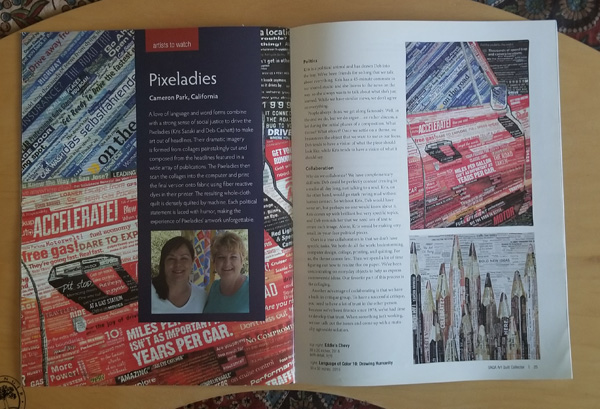When we were recently asked about our artist statement, we made the ugly realization that it had been a while since we had written one. Even when we updated our website last fall, we didn’t pay attention to our artist statement and just cut and pasted the (outdated) information to the new website. That sure was a wake-up call. We’ve gone about rewriting our artist statement (skip to the end for the final result), and we thought it might be time for you to rewrite yours or write your first one. Here are some thoughts we wanted to pass on.
Define Your Goal
What exactly are you writing? Galleries and exhibition curators often ask for both a biography and an artist statement (the how, what, and why you create). Just concentrating on the artist statement today, think about the following:
- Voice. If you are writing for a specific gallery or exhibition, find out if they want the statement in the first person or third person. This is your opportunity to write two versions and have them ready for any occasion.
- Length. Unfortunately, there is no national statement length policy. Sure would make things easier! We’ve written artist statements that ranged between 50-200 words. Find out if there is a word limit for the exhibition or gallery you’re writing for. If you are writing a general artist statement, see if you can write a 100-word statement. It’s easier to scale back or add from something you’ve already written.
- Topic. Are you writing an artist statement for a particular work, a series, a solo show, or your entire body of work? Keep all your versions. For individual works, sometimes a sentence or two is all you need. And keep updating your artist statements. You’ll never know when you’ll need them.
Write, Write, Write!
Sometimes it is really hard to get started. Here are some strategies we’ve employed:
- Read. Read other people’s artist statements. You will quickly recognize the good ones. Keep them for reference.
- Don’t Worry. Just write. Don’t expect to write the perfect statement at first. Write down individual sentences, words, and thoughts. Then go back and try to flesh out what you want to say. Getting the ideas down on paper (or computer) gives you a good start.
- Collect. Collect good words. Whenever you see a good word, one that is descriptive without needing an adjective, one that is specific, one that is jargon-free, keep it in a file for future use. Deb just collected a new word, “ready-made words.” And one of our all-time favorite words is “haptic.” It may seem a bit esoteric, but we explain the word as a means to reach out to our viewers. If we didn’t need to run our hands over our quilts, we would stop at the collage stage.
“haptic” [hap-tik] adj.
1 : relating to or based on the sense of touch
2 : characterized by a predilection for the sense of touch (a haptic person)
Get Input
Finally, whatever you do, have someone else look at what your artist statement. We’re lucky because there are two of us to go over our statements, but there is a lot you can do, too. Good luck!
- Use the Computer. It’s not perfect, but if you have spell check and grammar check on, you can at least avoid the really crazy boo-boos.
- Use a Friend. Trade editing jobs with another artist. They will at least let you know if you’ve articulated the “why” of your statement well.
- Hire an Editor. If you can afford it, it pays to have a professional look at your work.
- Use Resources. Don’t reinvent the wheel, we didn’t. There are lots of resources out there, but we took a look at Vicki Krohn Amorose’s Art-Write: The Writing Guide for Visual Artists. If you are a member of SAQA, you can listen to a webinar that features Amorose. (Scroll down to the bottom of the page for the link to the recorded webinar.)
- Get Lucky. We were featured in Issue 5 of Art Quilt Collector (now known as Art Quilt Quarterly) under “Artists to Watch.” Martha Sielman, the executive director of Studio Art Quilt Associates (SAQA), wrote the best introduction about us we’ve ever read. We got her permission to use it, but we’ve edited it here to keep it current. By the way, this artist statement is 94 words long.
A love of language and word forms combine with a strong sense of social justice to drive the Pixeladies (Kris Sazaki and Deb Cashatt) to make art out of headlines. Their dramatic imagery is formed from collages painstakingly cut and composed from the headlines featured in a wide array of publications. The Pixeladies then scan the collages into the computer and have the final version printed onto fabric. The resulting whole-cloth quilt is densely quilted by machine or by hand. Each political statement is laced with humor, making the experience of Pixeladies’ artwork unforgettable.


2 responses to “Writing An Artist Statement”
Thank you for this intelligent, composed and informative statement. You have presented a great deal of food for thought, while providing a new direction for my own artist statement. The third person statement allows an artist to be removed from the trap of hubris.
Thanks, Linda, for your kind words!